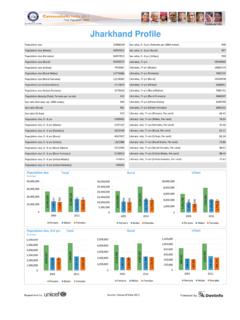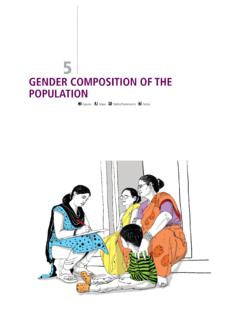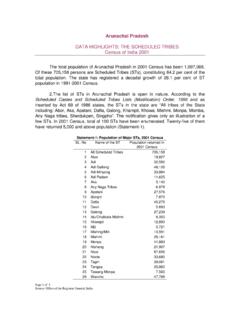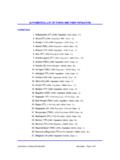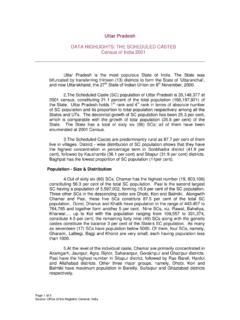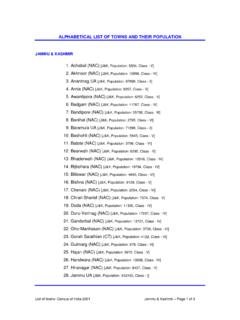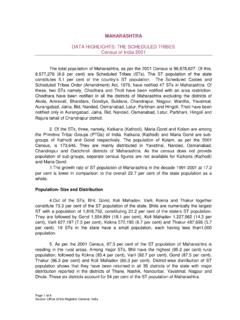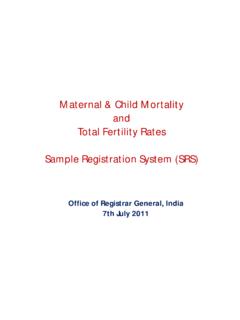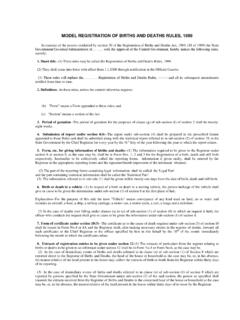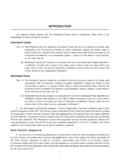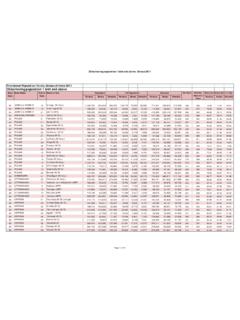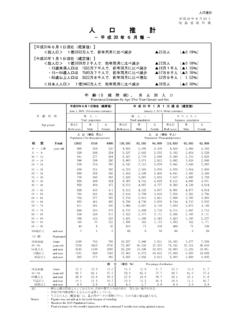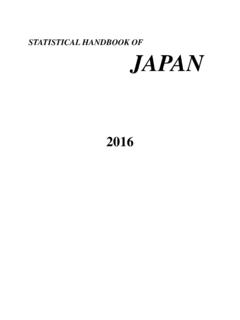Transcription of Provisional Population Totals Urban …
1 1 | P a g e Census of India 2011 Provisional Population Totals Urban Agglomerations and Cities Data Highlights This data release covers the total Population , Population (0 to 6 years) and number of literates for each UA/City with a Population of 1 Lakh and above as per the Provisional Population Totals of Census 2011. Definitions: Towns: For the Census of India 2011, the definition of Urban area is as follows; 1. All places with a municipality, corporation, cantonment board or notified town area committee, etc. 2. All other places which satisfied the following criteria: i) A minimum Population of 5,000; ii) At least 75 per cent of the male main working Population engaged in non-agricultural pursuits; and iii) A density of Population of at least 400 persons per sq. km. The first category of Urban units is known as Statutory Towns. These towns are notified under law by the concerned State/UT Government and have local bodies like municipal corporations, municipalities, municipal committees, etc.
2 , irrespective of their demographic characteristics as reckoned on 31st December 2009. Examples: Vadodara (M Corp.), Shimla (M Corp.) etc. The second category of Towns (as in item 2 above) is known as Census Town. These were identified on the basis of Census 2001 data. Urban Agglomeration (UA): An Urban agglomeration is a continuous Urban spread constituting a town and its adjoining outgrowths (OGs), or two or more physically contiguous towns together with or without outgrowths of such towns. An Urban Agglomeration must consist of at least a statutory town and its total Population ( all the constituents put together) should not be less than 20,000 as per the 2001 Census. In varying local 2 | P a g e conditions, there were similar other combinations which have been treated as Urban agglomerations satisfying the basic condition of contiguity.
3 Examples: Greater Mumbai UA, Delhi UA, etc. Out Growths (OG): An Out Growth (OG) is a viable unit such as a village or a hamlet or an enumeration block made up of such village or hamlet and clearly identifiable in terms of its boundaries and location. Some of the examples are railway colony, university campus, port area, military camps, etc., which have come up near a statutory town outside its statutory limits but within the revenue limits of a village or villages contiguous to the town. While determining the outgrowth of a town, it has been ensured that it possesses the Urban features in terms of infrastructure and amenities such as pucca roads, electricity, taps, drainage system for disposal of waste water etc. educational institutions, post offices, medical facilities, banks etc. and physically contiguous with the core town of the UA. Examples: Central Railway Colony (OG), Triveni Nagar ( ) (OG), etc.
4 Each such town together with its outgrowth(s) is treated as an integrated Urban area and is designated as an Urban agglomeration . In the 2011 Census, 475 places with 981 OGs have been identified as Urban Agglomerations as against 384 UAs with 962 OGs in 2001 Census. Number of UAs/Towns and Out Growths (OGs): Type of Towns/UAs/OGs Number of towns 2011 Census 2001 Census 1 Statutory Towns 4,041 3,799 2 Census Towns 3,894 1,362 3 Urban Agglomerations 475 384 4 Out Growths 981 962 At the Census 2011 there are 7,935 towns in the country. The number of towns has increased by 2,774 since last Census. Many of these towns are part of UAs and the rest are independent towns. The total number of Urban Agglomerations/Towns, which constitutes the Urban frame, is 6166 in the country. 3 | P a g e Population of UAs/Towns: 1. The total Urban Population in the country as per Census 2011 is more than 377 million constituting of the total Population .
5 2. Class I UAs/Towns: The UAs/Towns are grouped on the basis their Population in Census. The UAs/Towns which have at least 1,00,000 persons as Population are categorised as Class I UA/Town. At the Census 2011, there are 468 such UAs/Towns. The corresponding number in Census 2001 was 394. 3. million persons, constituting 70% of the total Urban Population , live in these Class I UAs/Towns. The proportion has increased considerable over the last Census. In the remaining classes of towns the growth has been nominal. 4. Million Plus UAs/Towns: Out of 468 UAs/Towns belonging to Class I category, 53 UAs/Towns each has a Population of one million or above each. Known as Million Plus UAs/Cities, these are the major Urban centres in the country. million persons (or of the Urban Population ) live in these Million Plus new UAs/Towns have been added to this list since the last Census.
6 5. Mega Cities: Among the Million Plus UAs/Cities, there are three very large UAs with more than 10 million persons in the country, known as Mega Cities. These are Greater Mumbai UA ( million), Delhi UA ( million) and Kolkata UA ( million). The largest UA in the country is Greater Mumbai UA followed by Delhi UA. Kolkata UA which held the second rank in Census 2001 has been replaced by Delhi UA. The growth in Population in the Mega Cities has slowed down considerably during the last decade. Greater Mumbai UA, which had witnessed growth in Population during 1991-2001 has recorded during 2001-2011. Similarly Delhi UA (from to in 2001-2011) and Kolkata UA (from to in 2001-2011) have also slowed down considerably. Child Population (0-6 years): 6. Population of children in the age group is million in Census 2011. In the Urban areas there are million children in this age group.
7 In comparison to Census 2001, the number of children (0-6) in Urban areas has increased (by ), while in the rural areas it has decreased by 7. Of the million children (0-6) in the Urban areas in the country, the Population in Class I UAs/Cities is million, which is about of the total Urban child Population . In Million Plus UAs/Cities the Child Population (0-6) is million constituting about 40 % of the total Urban child (0-6) Population of the country. 8. Among the 53 Million Plus UAs/Cities million are children (0-6), of which are boys and are girls, showing a preponderance of male children in these large cities. 4 | P a g e 9. Malappuram UA has the highest proportion of Children (0-6) ( ) in the Million Plus category, followed by Ghaziabad ( ). Kolkata UA has the lowest proportion at Sex Ratio 10. Sex ratio, the number of females per thousand males, in Urban areas in India is 926 in Census 2011.
8 It has registered an increase of 26 points over the Sex Ratio in 2001 Census. 11. Sex ratio in Class I UAs/Cities ( Population of 100,000 and above) is 921, which is 5 points lower than the total Urban sex ratio in the country. 12. Among the Million Plus UAs/Cities the Sex Ratio stands at 912. The UAs, where Population of females exceeds the total male Population in this group are Kannur UA (Kerala) at the top with 1168. Surat UA (Gujarat) is at the bottom of the list with Sex Ratio at 754 where males outnumber females. 13. In the two of the three mega cities there is predominance of male Population as they have returned low Sex Ratio ( , Greater Mumbai UA - 861, Delhi UA 867). Kolkata UA has returned a better Sex ratio at 928. Child Sex Ratio (0-6 years): 14. The Child Sex Ratio in the country has declined from 927 to 914 in Census 2011. This decline is more pronounced in rural areas than in Urban areas of the country, where the decline is by 4 points from 906 to 902 in Census 2011.
9 15. The Child Sex Ratio in UAs/Cities with 100,000 persons and above is 899 which is a shade lower than the national average for Urban areas. 16. The combined Child Sex Ratio in Million Plus UAs/Cities is 898. Thiruananthapuram UA (Kerala) has returned the highest Child Sex Ratio (971) in this group. The lowest slot is occupied by Agra UA (780). 17. Child Sex Ratio in the three Mega Cities are 946 (Kolkata UA), 900 (Greater Mumbai UA) and the lowest in 868 (Delhi UA). 5 | P a g e Literacy Rate 18. The literacy rates among both males and females have shown improvement in Census 2011 compared to the last Census. The literacy rate in the country as a whole is In the rural and the Urban areas the literacy rates are and respectively. 19. The female literacy rate in rural and Urban areas shows wide variation. In the Urban areas of the country the female literacy rate is in the rural areas it is only 20.
10 In the 468 UAs/Towns the progress in literacy has been quite encouraging. In 89 UAs/Cities the total Literacy Rate has crossed the 90% mark. The corresponding number of UAs/Cities in Census 2001 was only 23 in Census 2011. In another 288 UAs/Cities, the Literacy rate ranges between 80% to 90%, improving from 197 in Census 2001. 21. The total Literacy Rate in Greater Mumbai UA is , the highest among the mega cities. The Literacy Rate in Delhi and Kolkata are and respectively. The female literacy rate is also the highest in Greater Mumbai UA ( ) the top three megacities.
